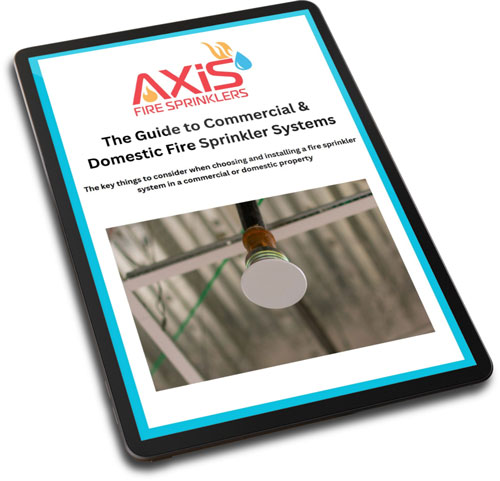Fire Sprinkler Systems Guide
Fire sprinkler systems have long been regarded as a vital line of defence against the deadly onslaught of fire. Being proactive and reliable, these systems operate as a dynamic shield that offers unparalleled fire protection.
Axis Fire Sprinklers can help you navigate these life-saving processes, ensuring optimal safety in both commercial and residential settings.
Based on your circumstances, property type and legal regulations the right type of fire sprinkler system can vary. In this guide, we are going to explore your options and ensure you can make informed decisions regarding your safety.
Fire Sprinklers: Revolutionising Fire Safety
Fire sprinklers work as a dynamic shield against fire outbreaks. Consisting of a water supply system that delivers optimal pressure, the system integrates seamlessly with a water distribution piping network.
The sprinklers, placed strategically throughout the building, are the front-line soldiers, ready to defeat any fire threat. In years past, fire sprinklers were seen primarily in factories and commercial buildings, but the game has changed. Cost-effective solutions now bring this vital safety measure within reach for homes and smaller structures.
Annually, over 40 million sprinkler heads are installed worldwide, offering protection not just for buildings, but more importantly, for the lives within them. In 96% of buildings equipped with fire sprinkler systems that have experienced fires, the systems effectively controlled the situation.
It makes sense for all properties to have fire sprinklers installed and the UK legislation has caught up.
In a significant policy update in November 2020, the laws regulating fire sprinkler systems were revised. The change now demands that all new or heavily renovated properties, that reach a height of at least 11 meters, must include fire sprinkler systems.
Fire sprinklers at home are now more than just legal requirements – they serve as swift emergency responders. They can restrict or smother a fire faster than it would take for the emergency service to get to the scene.
With 84% of cases involving only a single sprinkler, they deliver focused water spray onto the fire directly.
Residential fire sprinklers have been shown to effectively manage fires 96% of the time. This effectiveness translates into a diminished risk of inhabitants dying in a home fire by 81% and a decreased likelihood of major property damage by 70% if a system is operational.
Building a Proactive Approach to Fire Safety
Fire sprinkler systems are more than a safety net; they are a formidable force against fire outbreaks. They are an active shield, structured around a water supply system delivering optimal pressure and flow rate.
This system intricately meshes with a water distribution piping network that connects to strategically positioned fire sprinkler heads.
In 96% of buildings fitted with these systems, fires were effectively managed and lives saved.
Dry Risers
Dry risers, akin to empty water pipes, are vital for firefighting in buildings. They connect to a water source during emergencies, boosting water pressure and offering freeze protection.
In the UK, dry risers must be within 18 metres for fire engine access and are frequently housed in fire-resistant shafts within buildings. They come in two types:
- Dry Standpipe: Connects to fire hoses on each floor externally.
- Dry Pipe: Fire Sprinkler System: Pre-filled with air until activated by a sprinkler to contain fires.
These systems are designed to ensure enhanced water pressure and freeze protection during emergencies.
These are integral components of multi-storey buildings, connecting the water source to the building’s sprinkler system.
Fire Sprinkler Heads
Fire sprinkler heads are integral to any system. They release water when a fire is detected, and each design includes a unique triggering mechanism.
Conventional heads, suitable for most residential systems, direct a few droplets onto the ceiling. Meanwhile, upright or pendant spray sprinklers are ideal for high-ceiling spaces and shooting water straight down.
For a less conspicuous design, sprinkler heads can be tucked into the ceiling or covered with resin caps.
Each head is designed to release water when a fire is detected, thereby managing the fire effectively. Importantly, each head operates independently, ensuring maximum efficiency and minimal damage.
UK Regulations For Residents and Businesses
In the UK, fire safety regulations, including those for fire sprinklers, are set by national laws, building regulations, and local guidelines.
These standards, relevant for both commercial and residential buildings, ensure occupants’ safety.
Commercial Regulations
For commercial structures such as offices or warehouses, the Regulatory Reform (Fire Safety) Order 2005 is key. This mandates a fire risk assessment, which defines whether fire sprinklers are necessary – highly suggested in high occupancy or flammable material storing areas.
BS EN 12845 is the British Standard stipulating the design and maintenance of these systems.
Residential Regulations
Residential building regulations are outlined in the Building Regulations Approved Document B (Fire Safety), and the requirement for sprinklers is generally based on aspects like building height or size.
Notably, following the devastating Grenfell Tower incident, the rules have been amended, with the height where sprinklers are required reduced from 30 to 11 meters. This implies any new building over four storeys will need sprinklers installed.
In Wales, as of 2016, sprinklers are obligatory in all new and converted residential properties.
What This Means For You
Installation and maintenance of sprinkler systems should be done by reliable fire safety firms, meeting standards BS EN 12845 and BS 9251 for commercial and residential properties, respectively.
Regular inspections and maintenance are crucial to ascertain the system’s operational efficiency.
Understanding and complying with fire safety regulations not only meets legal requirements but significantly augments the safety of buildings, offering reassurance to occupants and owners alike.
Systems Customised to Your Needs
Axis has a range of fire sprinkler systems that can be customised to your needs and all are installed to meet national regulations.
If your building has a strong water flow rate and good water pressure, a mains system might be your ideal choice. It eliminates the need for water tanks and pumps, making the installation process more cost-efficient.
Should your building lack the optimal water pressure, don’t fret. Pump systems are designed to rectify the issue, ensuring you have the correct water pressure and flow for your sprinkler system.
Alternatively, you can opt for the pump and tank systems if your main water flow falls short. With water stored in anticipation, the pump propels water with precision to the awaiting sprinkler heads when the need arises.
Axis Fire Sprinklers: Proactive Fire Protection
Whether it’s a commercial high-rise or a residential home, fire safety should never be compromised.
With Axis Fire Sprinklers, you’re guaranteed top-tier systems that prioritise your safety above all else and provide the protection you need during the worst events.
Join the millions who trust in fire sprinkler systems and make the smart choice for fire safety today.
Contact Us Today
To learn more about our fire sprinkler systems or request a quote, please contact the team today.
We are more than happy to help with your safety needs and meet national standards on all sites.


